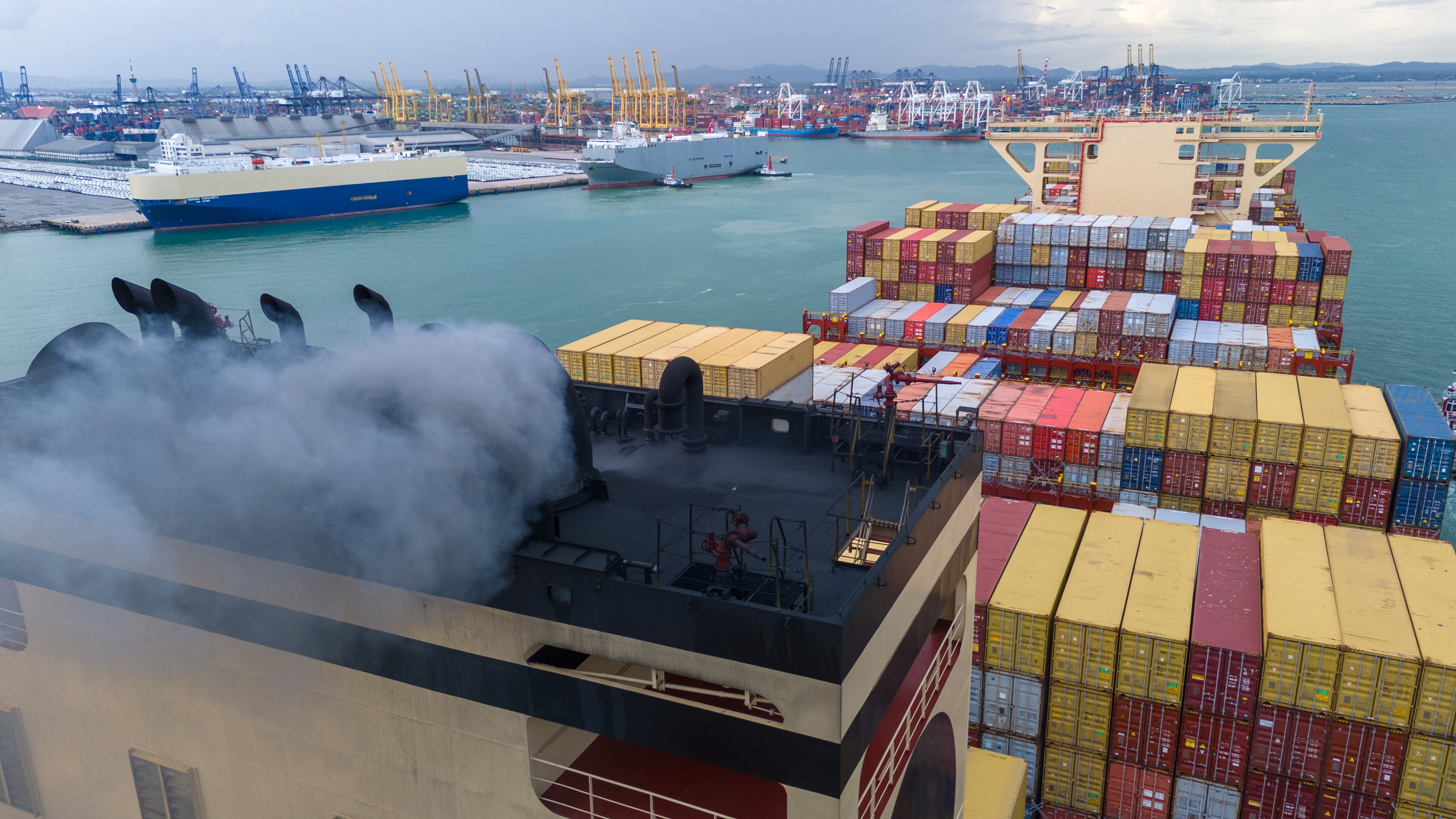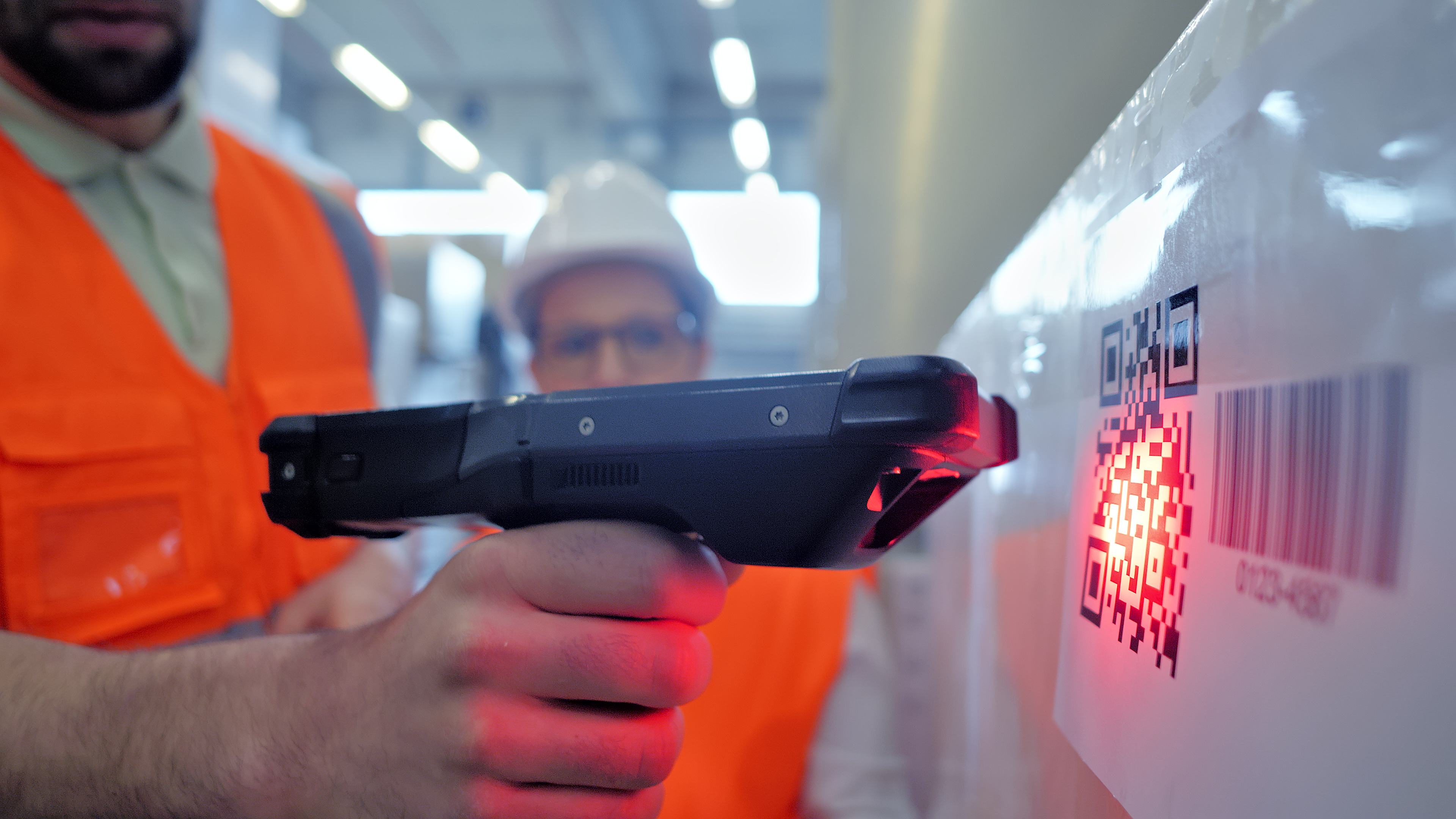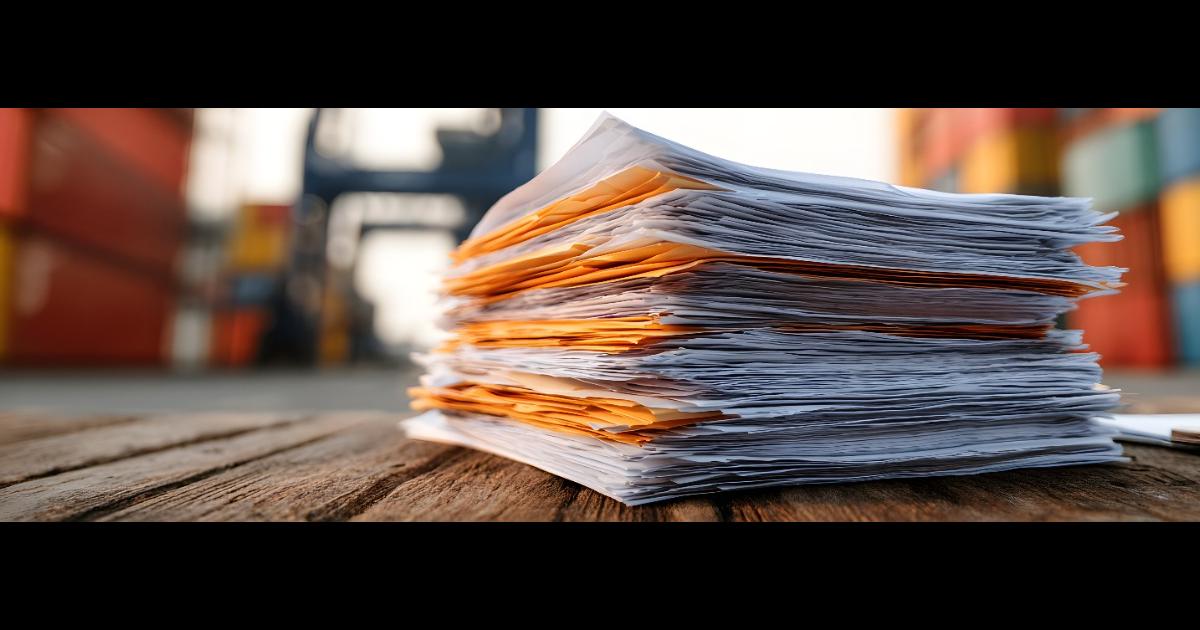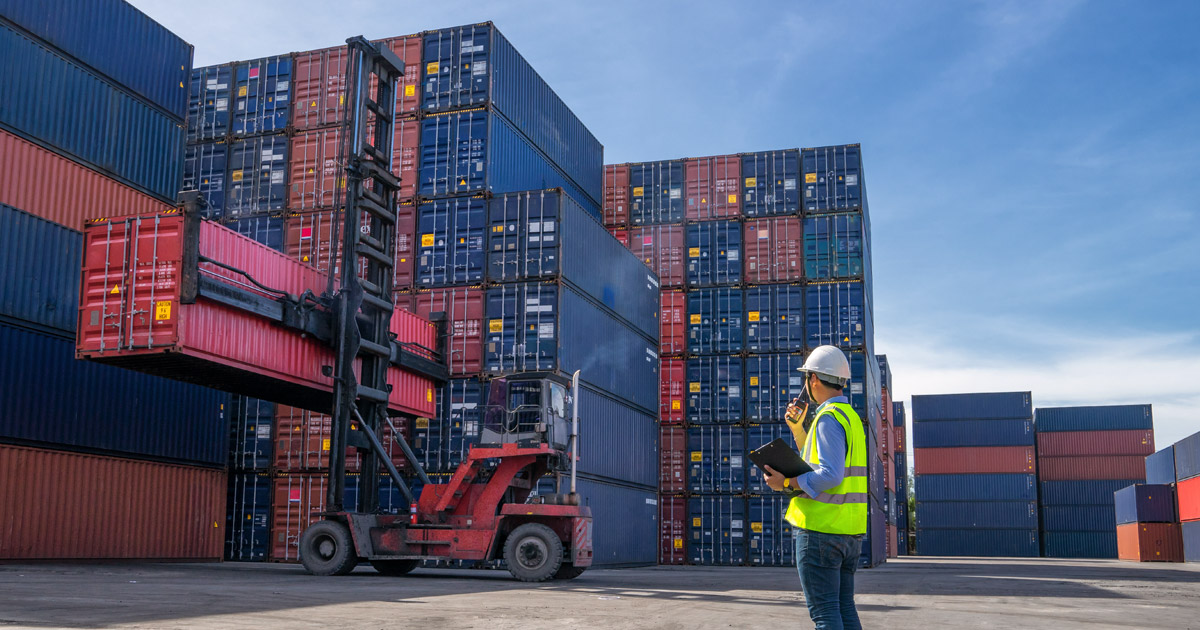
Shipping FBA products from China to the UK is one of the highest costs you will face as an Amazon seller.
If this is your first attempt at organising a shipment from China to the UK, the number of steps and conditions can feel overwhelming.
Moreover, it’s vitally important to comply with Amazon’s FBA preparation requirements, safety requirements and product restrictions otherwise they may refuse to accept delivery of your goods, dispose of, or return your inventory and block future shipments.
In this how-to guide, we walk you through the entire shipping process step-by-step. We provide detailed advice about how to create a shipping plan in your Amazon Seller account, how to correctly prepare and label your products and examine your shipping options.
The purpose of this how-to guide is to help you confidently ship goods from China to an Amazon FBA warehouse without making mistakes that will have financial repercussions.
In addition, we also detail the international shipping process, costs and times to help you determine your best shipping options. We also explain the pros and cons of using a freight forwarding service.

HOW TO CREATE A SHIPPING PLAN FOR AMAZON FBA
In your Amazon Seller Account, you will need to create a Shipping Plan. This informs Amazon what items you’re shipping to their FBA centre.
This process involves selecting products you have already added to you Amazon Seller account and preparing the goods for shipment from China to the UK.
You will need to follow this process every time you order merchandise from your supplier in China. However, once you have set up this first template, you can use the same shipping plan for repeat orders.
Step 1: Manage Inventory
From your home screen, click on the Inventory menu and select the Manage Inventory page. Select all the “Active” products you want to add to your shipping list by checking the box on the left.
If you need to include quantity discounts click the ‘edit’ tab on the right and enter the amount of the discount.
Once you have completed the inventory, click on the drop-down menu and select Send/replenish Inventory from the Action on Selected option.
Step 2: Send/Replenish Inventory
On the Send/Replenish Inventory page you have one of two options:
- Create a new shipping plan
- Add to an existing shipping plan
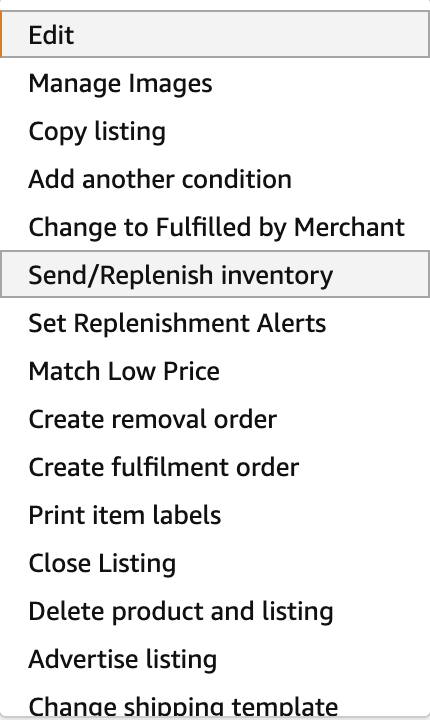
Step 3: How To Complete the Ship Form
Once you have created your shipping plan confirm the shipping address in the Ship From field.
Note:
- The shipping address is the location from where your shipment will be collected from to take to an Amazon Fulfilment centre.
- This address will not be the address of your product supplier but the final drop-off of your shipment before it is shipped to your choice of Amazon FBA. For example, it could be the offloading warehouse at the port of entry or the final destination you instruct your freight-forwarding company to deliver your shipment.
- The address you insert in the Ship From field should correspond with the address you provide the freight forwarding company. (More about that later)
Ideally, the freight forwarding company you use should be familiar with Amazon FBA shipping requirements. The reason we say this is because Amazon-friendly freight forwarders understand Amazon’s packing and shipping guidelines and make the end-to-end shipping process much easier.
Step 4: Individual Products v Case Packed Products
The next step is to confirm the type of product you are shipping to Amazon. Again, there are two options.
- Individual products
These can be single products purchased in bulk but in varying quantities or a selection of multiple different types of products. Manufacturers refer to these items as the “inner carton”. These boxes are then packed into a larger box known as the outer carton so your entire order is kept together.
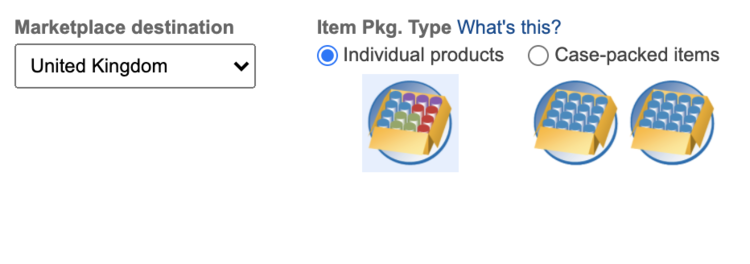
- Case-packed products
Multiple cases of the same product which have matching SKU (a products unique identifier). Each of the cases should have an equal amount of products and the same conditions.
Once the above details are updated and checked, click the continue to shipping plan tab in the bottom right-hand corner to navigate to the All Products page.
Step 5: Confirm Quantity
On the All Products page, you will see a full list of the inventory you have just created. You need to confirm how many products you are shipping. There are two boxes to complete:
- How many units per case - this is the number of inner cartons per box
- How many cases - this is the number of outer cartons you are shipping
Once these details are complete, you need to provide information about who will prep the boxes and how they will be labelled.

AMAZON SHIPPING GUIDELINES
To finalise your shipping plan you need to prep the boxes. This provides Amazon with information about whether your products will need preparing (bubble wrap, bagging, tape etc) once it arrives at their fulfilment centre.
Step 1: Preparing Your Products For Amazon FBA: Who Preps?
To ensure your products will be accepted by an Amazon FBA warehouse, it is important that you have correctly packaged your FBA inventory.
Under the prepare products tab, click the Who Preps option. This will bring up two choices; Amazon or Merchants.
It is advisable to have your supplier prepare the products so they are ready for delivery. Amazon does provide an FBA prep service but charges a per-item fee. You can find out more about how much Amazon charges for their FBA Preparation Services here.
Alternatively, work with a freight forwarding company that understands Amazon’s FBA policies and requirements.
There are freight forwarding companies in the UK that will prep your goods when they arrive at a UK port before sending them on to Amazon’s designated fulfilment centre.
For small packages, Amazon provides a delivery service using recognised courier service (DHL, UPS, FedEx, Royal Mail). Bear in mind, Amazon charges a per-item fee to use this service. It can be expensive.
If you prefer to use a freight-forwarding company that ships products from China to the UK, click the Who Preps tab.
Fragile or Hazardous Goods To Amazon?
Fragile and goods that are deemed hazardous (called Hazmat) should be packaged correctly so there is no risk of them getting damaged in transit. You will need to ensure your supplier meets the following requirements:
- The packaging must be sufficient enough for the goods to survive a 3-foot drop onto a hard surface
- The outer packaging must be packed in six-sided boxes called corrugates
- The products must be provided with sufficient ‘cushioning’ such as bubble wrap, foam wrap and/or corrugated dividers
- Fragile items must be individually wrapped and held firm. They should not be able to move.
- Clearly mark the box with a ‘Fragile” label on all sides of the package
It’s worth noting that good packaging can earn a five-star rating from Amazon customers.
To ship Hazmat, you are obligated to provide complete and correct information about your products and file safety data sheets (SDS) and exemption sheets when you list your products.
Amazon classifies hazardous goods as “substances or materials that may pose a risk to health, safety, property or the environment while storing, handling or transporting because they contain flammable, pressurised, corrosive or otherwise harmful substances.”
Damaged Hazmat items, including damaged lithium batteries, must be appropriately disposed of at a recycling centre. They are not returnable.
Step 2: Labelling
The next step is to label your products. Amazon needs a reference number and wants to know whether you’ll be using a UPC or EAN barcode, or a unique Amazon code known as an FNSKU.
Amazon would prefer sellers to use an FNSKU because they are unique to each seller and makes it easier for them to manage your stock. They also charge a fee for this service.
For your own financial gain, the best option is to organise an SKU with your supplier.
Note: Merchant SKUs are not shipping labels, they are product labels. If your products already have a manufactured UPC or EAN barcode on them already, they may be obscured with packaging such as bubble wrap. Each product must include an SKU label on the exterior of the box where it can be scanned by Amazon’s FBA team.
Every product your send via an Amazon FBA centre must have a scannable label. The best option is to prepare labels through your supplier. For a small fee, use Amazon’s FBA Label Service and FBA Preparation Service.
If you prepare the labels through your supplier be aware that some products can be shipped using the manufacturer's barcode (an SKU). These items are known as ‘stickerless, commingled inventory’.
Products that are not eligible for stickerless, commingled inventory, must be clearly labelled by the merchant.
The positioning of the label is important. Amazon insists barcodes are affixed to products under the following terms:
- A barcode is placed on each item
- Other visible barcodes are covered except product serial numbers or transparency authentication codes
- Barcodes are placed on the outside of any prep materials
- Do not place barcodes on curves or corners
Check that the product barcodes match the ASINs listed in your Amazon Shipping plan otherwise Amazon’s fulfilment centres will refuse delivery.
Under the Who Labels tab select the appropriate option:
- FBA Label Service
- Merchant
Double-check the details are correct then click Print Labels.
Step 3: Review Shipment
In the Review Shipment page, check all the details have just entered are correct. Amazon will then confirm which FBA warehouse(s) your products will arrive to.
Be warned, if your shipment contains multiple boxes they may not all be shipped to the same fulfilment centre. FBA’s are assigned by Amazon automatically. You do not have the option to choose your own destination unless you sign up for the FBA Inventory Placement Service - for another additional service fee.
Shipments will be awarded a name, date, time and number of shipments included in the plan. If you are shipping multiple cases, you may want to change the shipping name to something that is more readily identifiable for tracking in transit.
When you are happy that all the details are correct, click Approve Shipments.
Step 4: Preparing Shipment from China to the UK
To finalise your shipping plan with Amazon, you are taken to the Prepare Shipment page. Here, you can arrange how your goods are transferred from the freight forwarder’s port warehouse to the Fulfilment Centre assigned by Amazon.
Select the Work on Shipment for each designated Fulfilment centre. This gives you the option to
- Choose the carrier(s) of your choice
- Select the number of boxes
- Set a schedule
- Pay for final delivery (fees are automatically updated)

What is the Difference Between SPD v LTL?
Amazon sellers making their first shipment from China to the UK can often be uncertain about whether to ship SPD (small parcel delivery) or LTL (less than truckload).
Amazon provides shipping guidelines as follows:
- Small Parcel Delivery (SPD) with a partnered carrier - select this if your shipment is no more than 200 product per case
- Small Parcel Delivery (SPD) with a non-partnered carrier - select this if your shipment is no more than 500 products per case
- Less than truckload (LTL) - select this option if your shipment is more than 500 products and less than 5000 products per case
How to prepare boxes for shipping small package delivery (SPD)
- Products shipped in cartons should be no bigger than 63.5cm or weight more than 23kg
- Carton dimensions should not exceed 63.5 cm on any side
- Single boxes should not weigh more than 23kg
- Boxes that weigh in excess of 15kg should be marked “Heavy Package” viewable from all sides
- Delivery labels should be placed no closer than 3cm from the natural edge of the box
How to prepare boxes for shipping less than truckload (LTL)
- Pallets must include the name of the vendor, the address you are shipping from and the address you are shipping to
- Record PO numbers when applicable together with the number of cartons and the number of pallets if more than one pallet. When there is more than one pallet they should be labelled “pallet 1 of 3, pallet 2 of 3, pallet 3 of 3” etc.
- Pallets that are carrying a variety of products must be labelled ‘mixed merchandise’ and ‘mixed SKUs’
- Individual cartons on the pallet should adhere to the carton guidelines above
- Pallets should not exceed 180cm in height when single-stacked
- Double-stacked pallets for the UK should not exceed 3.0m
- The total weight of a pallet must not exceed 500kg
- Pallets must be safe to unload
Due to Amazon’s strict guidelines in relation to pallets and cartons, we recommend working with a freight forwarding company that is familiar with Amazon’s shipping guidelines.
If you decide to cancel a shipment, all you need to do is navigate to the Send/replenish inventory page and click on Delete plan.

Should I Ship Pallets or Cartons?
When arranging shipment with your freight forwarding company, you will need to order a pallet or a carton in accordance with Amazon’s guidelines given above.
Oftentimes the decision will be simple. For your first order, you may want to weigh up the pros and cons of each as it could have an impact on how much inventory you order.
Pros and Cons of Shipping with Cartons
Advantages
- Cartons are parcels shipped in a cardboard box or sturdy container
- They are not expensive
- Cartons have good strength to weight ratio
- They do a great job of protecting your goods form damage
Disadvantages
- Cartons are not weatherproof and can become deformed under pressure when stacked in a pile.
Pallets
For bulk shipments, palletising your boxes makes it easier for the freight-forwarder to handle your shipment and keep a track of your inventory.
Pallets are also stronger than other shipping containers and increase the protection of your goods.
Pallets are recommended for heavier shipments. Although weights may differ from one freight forwarder to the next a general guide is:
- 1/4 pallet for between 40-250 kgs and 80cm in height
- 1/2 pallet for between 251-500kgs and 110cm in height

SHIPPING TO AMAZON FBA
What Are My Shipping Options?
The logistics of shipping FBA products from China to the UK can take up a lot of time, energy and expense. Ideally, you want to work with a UK freight forwarder that specialises in handling inventory for private label Amazon FBA UK sellers.
Moreover, the logistics company you use should also be familiar with the freight forwarding process from China to the UK. The reason for this is because the language barrier can pose problems for the first few shipments.
Your shipping options are:
- Use an FBA-friendly freight forwarder in the UK
- Use the supplier
- Use Amazon´s partner carrier for small shipments
Let’s weigh up the pros and cons of each option.
Arrange Fulfilment with an FBA-Friendly Freight Forwarder in the UK
A freight forwarding company with experience of coordinating the delivery of goods from China to Amazon’s warehouses in the UK can reduce the risk of things going wrong. Any miscommunication, unfortunately, comes at the expense of Amazon Sellers.
High-quality freight forwarding service providers will arrange end-to-end shipments on your behalf. Before choosing a freight forwarding service, enquire whether they tailor their services to meet your requirements.
Ideally, you want to work with a UK freight forwarding company that:
- Inspects goods for damages
- Ensure the size and weight of packages do not exceed Amazon’s limits and conditions
- Correctly label your boxes (and pallets)
- Ensures the barcode correctly informs Amazon what your item is, who it belongs to and where it has to go
- Pack your boxes on pallets in accordance with Amazon guidelines
- Determine whether your items are commingled inventory (self-labelled or with a manufacturers barcode) and organise appropriate action
- Arrange for your shipment to be cleared by customs, incorporate tax or duties and other charges upfront
- Arrange a delivery time slot
- Transport the products to the Amazon FBA Fulfilment Centre in the UK that you have specified
Pros and Cons of Using an FBA-Friendly Freight Forwarding Company
Advantages
- An FBA-friendly freight forwarder knows the ins-and-outs of Amazon’s shipping guidelines and will ensure your shipment will be received by Amazon’s warehouse including weights and measurements
- Eliminate the risk of Amazon refusing delivery at significant cost to yourself
- They will check the products you are shipping from China to the UK is good quality (If you consistently ship low-quality items to Amazon customers, you risk them negative feedback that can damage your reputation on Amazon. Customers may even return products to you at your expense.)
- They employ experienced shipping handlers which reduces the risk of your goods being damaged during transit
- They have an efficient inventory procedure to avoid your consignment being upheld or forwarded to the wrong location
- Typically offer end-to-end shipping services between China and the UK and will streamline your logistics planning
- Arrange duty and other shipping charges for you
- Avoid obstacles that can delay the delivery of your shipment
- Your shipment will be securely stored in warehouses throughout the entire shipping process
Cons
- There is the potential that your consignment can get lost during transit or damaged although the risk is minimal
- Shipping costs may be higher than other methods because you are paying for a professional service. Knowing how to reduce your shipping costs is advantageous.

Should You Use Air Freight or Ocean Freight
The choice between air freight and ocean freight will ordinarily come down to how quickly you need your goods. Cost and weight are also considerations.
Air Freight
The major advantage of air freight is that it's much quicker than shipping consignments by sea. You should expect your goods to arrive within 10 to 14 days. It is best used for light consignments under 300kg although can still be considerably more expensive than the ocean freight.
The major difference between air freight and ocean freight is cost. Sending cargo by air freight can cost 4-6 times as much as ocean freight. Costs vary depending on weight. Airlines charge by weight rather than volume.
There is also an argument to say that air freight is more reliable for moving fragile or valuable products because there are fewer places where cargo changes hands.
Airlines also have stricter rules on weight and hazardous materials. Anything over 300kg. Items that cannot be shipped by air freight include:
- Explosives
- Gases
- Flammable or radioactive products
- Items that are toxic, infectious, or with harmful chemicals
- Strong magnets
- Anything considered dangerous to public health
Ocean Freight
Ocean freight can carry large consignments so is better suited to high volume shipments.
Duty and VAT are less expensive because consignments are charged as a percentage cost of the goods you are transporting plus export costs
Larger items are more likely to be accepted by ocean freights than airlines
Specialist operators can ship goods from practically anywhere in the world - even remote areas.
Ocean freight is more environmentally friendly than air freight.
The disadvantage of ocean freight is consignments typically take between 35-40 days to be transported from China to the UK. With some freight forwarding companies, it can sometimes take as long as 8 weeks.
The pricing structure for small loads may not be cost-effective.
There is more risk of goods going missing or seized by pirates using ocean freight although the likelihood of this actually happening is very slim
What is the difference between LCL and FCL?
The volume of your shipment could significantly impact your shipping costs. When ordering goods from China consider the difference between Full Container Loads (FCL) and Less than Container Loads (LCL).
FCL is ideal for cargos that will fit on to a 20-foot or 40-foot shipping container, around 12-15 cartons and 24-30 cartons respectively.
LCL is better suited for smaller shipments. Although this is the less expensive option, with LCL, your consignment will be packed with goods from other suppliers.
This typically means the containers are opened and repacked more often so that goods can be delivered to other countries en-route. As a consequence, there is more risk of your order getting lost, damaged or delayed.
If your order verges on the tipping point, you may end up paying for an FCL rather than an LCL. Likewise, a 40-foot container is only 20-25% more than a 20-foot container but provides you with twice the volume.
Pros and Cons of Shipping via The Supplier
Organising your shipment through a freight forwarding company gives you more control over your consignment. However, passing the responsibility of shipping to your supplier may be financially beneficial and is certainly more convenient.
Some suppliers, especially large manufacturers, have attractive deals with freight forwarders and international couriers such as Royal Mail, FedEx, and DHL. In such instances, they may pay or all part of the shipping costs.
However, the downside is, they may integrate these shipping costs into the price of your products. This is something you may want to consider when shopping around for suppliers.
Some suppliers also offer to organise shipping costs because they get a commission on the cargo. Moreover, they don’t negotiate a good price and overcharge you for shipment when a more cost-effective solution is available to you.
Before you agree to your supplier organising shipment, enquire about the cost of using a freight forwarding company of your choice first.
Shipping through the supplier does not provide a quality guarantee. They may also fail to meet Amazon’s packing, labelling, measurement and safety requirements.
As a result, there is a higher risk that your shipment could be rejected by Amazon FBA. Moreover, they may ban you from using Amazon warehouses for future shipments.
Shipping with Amazon's Partner Carrier
Amazon’s partnered carrier program also offers several benefits including
- Faster processing speeds
- Lower shipping costs
- Up to £2000 insurance for lost or damaged inventory
- Easy payment options
- Shipment tracking
However, Amazon does not handle shipments over 135kg. Large consignments that exceed 135kg have to be arranged through a UK freight forwarder.
The other disadvantage of using Amazon’s logistics program is that you do not have any say in which operators are used in the logistics chain. That may mean you have to trust companies that have let you down in the past - which can cause unnecessary stress to some people.
What’s more, if the shipment does not meet the timeline you have promised your customer, the delay, despite not being your fault, could damage your reputation on Amazon.

WHAT IS THE INTERNATIONAL SHIPPING PROCESS?
International shipping can be complex. To ship goods from China to the UK, your inventory has to be passed through several companies.
Export haulage - your goods are taken by road from your supplier to the port.
Export customs clearance - goods have to undergo inspection by customs and excise in order to cross borders
Freight forwarding - goods are transported from the port of origin to the destination port. There could be stops in several countries on the way.
Import customs clearance - your goods must undergo compliance checks by border police in the UK
Import haulage - your goods are taken from the warehouse at the entry port to the designated Amazon FBA
For each step, paperwork is required to ensure your freight is delivered to the correct warehouse. Your goods also need clearing at customs at border crossings.
To successfully navigate customs, it is best advised to have a customs broker. Most freight forwarding companies will handle this for you.
The transportation of freight is also subject to international commercial terms (incoterms) that are agreed between the importers and exporters.
What are incoterms?
Incoterms stands for ‘International Commercial Terms' and outlines the arrangements between importers and exporters.
The terms cover everything from tasks, responsibilities, costs, taxes, and risks. A typical incoterm will include:
- Point of delivery when goods change hands
- Who has been appointed to handle goods between the point of delivery
- Transportation costs
- Import and export duty fees
- Insurance
In all, there are 11 types of incoterms, 7 that is used for all modes of transport and 4 that are specific to goods being transferred by ocean freight and inland waterways.
Incoterms for any mode(s) of transport
EXW (Ex Works)
The seller is responsible for ensuring the goods are available for collection.
The buyer is liable for costs of loading and moving the goods from the agreed place of collection to the place of delivery including customs clearance.
FCA (Free Carrier)
The seller fulfils their obligation to pass goods over to a carrier selected by the buyer. Once the goods have been collected by the courier from the seller's premises or other location, the cost and risk of moving goods to the destination pass to the buyer.
CPT (Carriage Paid To)
Seller is responsible for paying freight charges to transport goods to a location jointly agreed between the seller and the buyer. Responsibility for goods is passed to the buyer the moment the goods are collected by the carrier.
CIP (Carriage and Insurance Paid To)
Seller clears goods for export and pays freight and insurance costs involved for delivering goods via a third-party. However, the risk of damage or loss of goods is transferred to the buyer when the carrier receives the shipment.
DAP (Delivered at Place)
The seller delivers the goods to an agreed destination ready for unloading. Delivery by the seller is deemed complete once the goods are unloaded after which the buyer is responsible for the payment of customs clearance import duties and taxes.
DPU (Delivered at Place Unloaded)
Usually used when the buyer or seller want to deliver goods to somewhere other than a terminal. Here, the seller is tasked with unloading goods themselves, clears the goods for export and bears all the costs and risks. Once unloaded costs and risks pass to the buyer.
DDP (Delivered Duty Paid)
For freight that is being carried by water, you also need to know the four additional incoterms
FAS (Free Alongside Ship)
Seller is responsible for delivering goods to the designated port in China and placing them alongside the correct vessel. Once delivered, the buyer assumes all risks and costs.
FOB (Free on Board)
Seller is responsible for goods until they are delivered to named port of shipment and landed on board the correct vessel. Once completed, risks and costs pass to the buyer.
CFR (Cost and Freight)
Seller is responsible for clearing goods for export and delivering them to correct vessel at the port of shipment in China. The seller bears the cost of transport to the vessel, after which liability is transferred to the buyer.
CIF (Cost Insurance and Freight)
The seller is responsible for suitably packaging goods, clearing items for export and prepaying freight contract and insurance.
Intercoms do not cover:
- all the conditions of a sale;
- identify the merchandise or contract price of goods being sold;
- reference the method or payment terms;
- state when the title of ownership passes from the seller to buyer;
- specify which documents the seller must provide to facilitate customs clearance at the destination border;
- address liability for delayed, damaged or lost delivery

Customs Duty and VAT
Goods that are being transferred from China and to the UK are subject to customs duty, or excise duty together with import VAT. The cost of import taxes and customs duties are pre-determined by the incoterms.
- Import VAT is charged at a percentage of the value of the imported goods
- The buyer is responsible for clearing goods through UK customs and paying taxes
- The supplier should provide relevant documentation you need to clear the goods through customs
- Goods from China are also subject to import duty
- The cost of customs duties is payable depending on the type of goods
- To move goods to the UK from China you need an EORI number
The easiest way to handle customs duties and taxes is to arrange for your goods to be cleared by customs through a freight forwarder. They will have a system that is already set up to transfer the relevant information to HMRC.
Work with a Trusted Freight Forwarding Company
When you’re shipping FBA goods from China to the UK, it’s important you choose a freight forwarding company you can rely on. There are several reasons for this:
- Amazon sellers are given more exposure to organic listings when you receive positive reviews from customers. Late deliveries can have a negative impact on your ratings.
- There is the potential for your supplier in China to cut you out entirely. It is possible for them to sell goods to the UK market directly and use Amazon FBA. A trustworthy freight-forwarding company is discrete and does not reveal any involvement with Amazon FBA to merchants.
- Lastly, when shipping goods across international borders, you are required to pay ‘incoterm DDP’. Amazon FBA does not arrange your shipping taxes or customs fees on your behalf. Freight forwarding companies do. Failing to organise import and export will result in financial loss.
Don’t risk using a UK freight forwarding company that is not familiar with Amazon FBA Shipping requirements. Powercargo provides tailored end-to-end services from China to the UK.
Moreover, you can rely on our experienced handlers to ensure your goods are delivered to the right Amazon Fulfilment Centre intact and on time.
